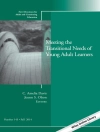This book addresses what is, perhaps, the single most important issue for vocational education; its relatively low standing in an era of high aspiration. The work explores the nature, extent and consequences for an educational sector that whilst having an increasingly important role in contemporary societies is seen to be of low standing across both countries with developed and developing economies.
Some of the standing is associated with the occupation it serves and this is highlighted in an era of high aspiration by young people and their parents. The consequences are far-reaching. This includes how governments and community view and support vocational education, parents and familiars advise about participation in it and young people’s decision-making associated with their post-school pathways. More than describing this problem, the focus of this collection is how this issue can be redressed through the actions of supra-government agencies, governments, schools in tertiary education institutions, industry and professional bodies and employers. It sets out the quality and extent of societal sentiments in shaping how vocational education and the occupation it serves are projected, across countries, continents and cultures, and offers a range of perspectives and contributions from scholars on how this issue might be redressed. These contributions are drawn together and synthesised into sets of propositions, practices and approaches directed towards governments, schooling and tertiary education institutions, educators, researchers, industry and professional bodies and employers. In this way, the book seeks to provide an authoritative, seminal, comprehensive and central text to understand and respond to this central issue for vocational education.
表中的内容
Section One – The standing of vocational education: Perennial issues, emerging concerns and ways forward .- 1. The standing of vocational education: a global concern with diverse meanings and implications (Barbara E. Stalder (Bern University of Teacher Education), Sarojni Choy and Anh Hai Le (Griffith University, Australia).- 2. Enhancing the standing and status of vocational education (Vibe Aarkrog (Aarhus University, Denmark) Stephen Billett and Steven Hodge (Griffith University, Australia).-
Section Two – Issues, sources and consequences of the standing and status of vocational education .- 3. Understanding the purpose and standing of technical and vocational education and training (Susan James Relly, University of Oxford, United Kingdom).- 4. Improving the image of VET: Perspectives from the developed and developing world (Stephen Billett & Anh Hai Le, Griffith University, Australia).- 5. A perspective on the challenges for the standing of the dual apprenticeshipsystem (Thomas Deissinger (University of Konstanz, Germany).- 6. Shaping young people’s decision-making about post-school pathways: Institutional and personal factors (Stephen Billett, Darryl Dymock, Steven Hodge and Sarojni Choy (Griffith University, Australia).-
Section Three – Country studies of the standing of vocational education and the occupation it serves .- 7. Alternance training as a way to improve attractivity of vocational education program in France (Laurent Veillard, Agrosup Dijon, France).- 8. Promoting the Standing of VET in Finland: Balancing Between Flexibility and Regulation- (Heta Rintala (Häme University of Applied Sciences) & Petri Nokelainen (Tampere University).- 9. Attractiveness of vocational education and training in India: Empirical findings of perspectives of employers, students and their parents and teachers (Matthias Pilz & Muthuveeran Ramayamy, University of Cologne, Germany).- 10. The quality and standing of school-based Norwegian VET (Hilde Hiim, Oslo Metropolitan University, Norway).- 11. The standing of vocational education in Vietnam: Implications for enactments (Anh Hai Le, Griffith University, Australia).- 12. Enhancing the standing of VET in Swiss Upper secondary education (Barbara E. Stalder, Bern University of Teacher Education, Switzerland).- 13. The interrelations of learning environment, enrolment in and completion of VET: A Danish case (Vibe Aarkrog, Danish School of Education, Aarhus University).- 14. Elevating the Standing of Vocational Education and Training in Romania (Maria-Carmen Pantea, BBU Cluj Napoca, Romania).-
Section Four – enhancing the standing and status of vocational education: an Australian study .- 15. Investigating enhancing the standing of vocational education and the occupation it serves: purposes: processes and phases, Anh Hai Le, Stephen Billett, Sarojni Choy and Steven Hodge (Griffith University, Australia).- 16. Perspectives of school students, parents, teachers (Phase 1) Steven Hodge, Stephen Billett, Sarojni Choy (Griffith University, Australia).- 17. Surveys of students, parents and teachers (Phase 2) Sarojni Choy, Anh Hai Le, Stephen Billett (Griffith University, Australia).- 18. Issues for and suggestions to enhance the standing of vocational education and the occupation it serves (Phase 3) Darryl Dymock, Stephen Billett, Sarojni Choy (Griffith University, Australia).
关于作者
Stephen Billett is Professor of Adult and Vocational Education in the School of Education and Professional Studies, Griffith University, Brisbane, Queensland Australia. His research interest are in learning the capacities required for paid work, through experiences in and across working life, educational institutions and their integration.
Barbara E. Stalder is Professor at the Institute of Upper Secondary Education, Bern University of Teacher Education, Switzerland. Her research interests are in in student engagement and learning, career development in vocational education and training, and career success over the life-course.
Vibe Aarkrog is an associate professor, Ph.D. of Vocational Pedagogy at the Danish School of Education, Aarhus University, Denmark. Her research concern pedagogical and curricula issues related to the interrelation of school-based and workplace-based learning in dual vocational education and training.
Sarojni Choy is a Professor of Adult and Vocational Education in the School of Education and Professional Studies, Griffith University. Her research interests are in vocational education and training, connecting educational experiences across different settings, continuing education and training, and workforce capacity building.
Steven Hodge is a Senior Lecturer in Adult and Vocational Educatoin in the School of Education and Professional Studies, Griffith University, Brisbane, Queensland Australia. His research is in the broad area of curriculum with particular interest in how curriculum is constructed, represented and interpreted.
Anh Hai Le is a lecturer and senior research assistant at Griffith University. Her research interest focuses on curriculum development in tertiary education, with a specific emphasis on the process of building knowledge through scholarly engagement with industry and higher education institutions.












